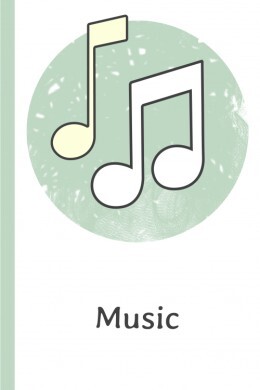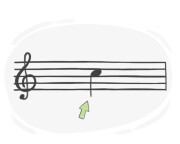the musical pitch A, which is a specific note in the diatonic scale commonly used in Western music
Music - Musical Notation
Here you will learn some English words related to musical notation such as "sharp", "fermata", and "glissando".
review
flashcard
spelling
quiz

a musical note that is held or sustained for the duration of four beats in 4/4 time, typically denoted by an open oval shape
a square-shaped notehead with no stem or flags representing a note duration equivalent to four whole notes in Western music
a set of notes based on a particular note that form the tonal basis of a musical passage
the C note situated approximately in the middle of the piano keyboard, often serving as a reference point for pitch
a symbol that cancels the effect of a sharp or flat, restoring the pitch of a note to its original state
the interval between the first and the last notes in eight diatonic degrees
three or more musical notes that form a harmony when played together
a musical symbol that indicates the raising of a note by two half steps or two semitones, equivalent to the same note as a natural but two half steps higher
a note symbol that represents a duration equal to half the value of a whole note, typically lasting for two beats in 4/4 time
the smallest interval used in Western music, equal to the distance between two adjacent notes on a keyboard or fretboard
a musical symbol placed over a note or rest to indicate that it should be held longer than its normal duration
a small round symbol in written music indicating augmentation of time by one half or staccato
a pair of upright lines in written music marking the end of a composition or a main passage
a note symbol representing a duration equal to one quarter of the value of a whole note
the first scale degree of a diatonic scale and the primary note upon which a musical composition or section is centered
a set of five horizontal lines and the blank space between them on which a musical composition is written according to a pitch
a short line added above or below the staff to represent a note that is outside the range of the staff
an upright line that separates the bars in written music
any of the signs written on the left-hand end of a staff indicating the pitch of the notes
a musical symbol that indicates the position of the G note on the staff, also known as the treble clef
a musical symbol used to indicate the position of middle C on a staff, and is commonly used for notating the pitches of instruments such as viola, bassoon, and cello
a musical symbol that indicates the position of the F note on the staff, also known as the bass clef
a musical symbol used to indicate that the written notes should be played or sung one octave higher or lower than notated
a type of clef used to notate rhythms without specifying pitch, commonly for percussion instruments
a system of musical notation used for fretted string instruments, representing finger placement on the instrument's strings and frets
a musical note symbol representing a duration equal to one eighth of the value of a whole note
a musical note symbol representing a duration equal to one sixteenth of the value of a whole note
a note symbol representing a duration equal to one thirty-second of the value of a whole note
a musical note symbol representing a duration equal to one sixty-fourth of the value of a whole note
a musical notation representing a very short duration of time, typically used in fast-paced music
a musical notation representing an extremely short duration of time, typically used in very fast-paced music
a horizontal line used in musical notation to connect two or more adjacent notes of the same value, indicating that they should be played as a single, continuous sound
a musical note with a dot placed to the right of it, which increases its duration by half, indicating that it should be held longer than a regular note of the same value
a percussive note played with reduced or muted volume, often used in drumming and rhythm guitar to add subtle accents or create a syncopated feel
a musical notation symbol indicating where a performer should take a breath while playing or singing
a musical notation symbol indicating a pause or break in the music, often used for dramatic or expressive effect
a musical symbol that indicates the lowering of a note by two half steps or two semitones, equivalent to the same note as a natural but two half steps lower
a musical notation indicating that the music should be played with a double beat, where the half note receives one beat
a curved line written over a pair of notes of the same pitch indicating that they should be played as one note
(music) a curved line indicating smooth, connected play between notes
a musical interval that is half the size of a semitone
a sign written at the beginning of a musical composition in the form of a fraction showing the number of beats in each bar
a symbol placed before a note to indicate that it should be played higher or lower than it is written in the key signature
a musical symbol that tells performers how to emphasize or articulate a note or group of notes to add expression and dynamic contrast
a musical term indicating that a note or passage should be played with a marked emphasis or accent
a musical term indicating that a note should be held for its full duration, typically marked by a horizontal line or dash above or below the note
a musical technique that involves sliding one or more fingers or the entire hand across the keys of a piano or the strings of a stringed instrument to produce a continuous, sliding sound
a musical technique where the notes of a chord are played individually in a sequence rather than simultaneously
a rapid alternation between two adjacent notes, usually a semitone or a whole tone apart
a musical ornament that is played quickly before the main note and is not essential to the harmony or melody of a piece of music
the set of marks at the beginning of a printed piece of music, indicating the key in which the piece is played
a musical ornament indicating a rapid alternation between a note and the note above or below it
a notation symbol consisting of two vertical lines with dots or arrows, indicating that a section of music should be repeated from the beginning or a designated point
a notation that indicates a grouping of a specific number of notes or beats within a time value, allowing for irregular rhythms or subdivisions
the relative duration or length of a musical note or rest












































